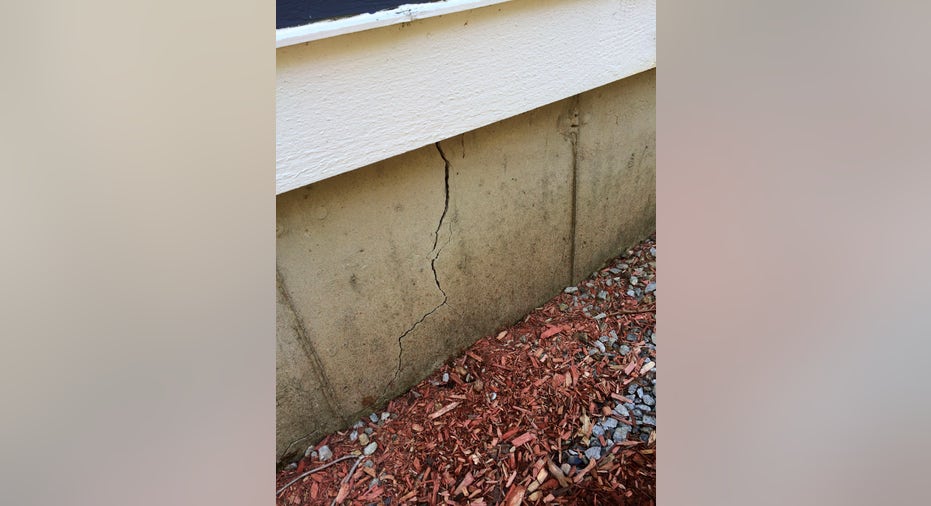Town coffers crumble along with a region's home foundations

WILLINGTON, Conn. – As the foundation beneath their home crumbles, Christina Mailhos and her husband are trying to figure out how to come up with $200,000 or more for the massive fix while college tuition bills loom for two teenagers.
But that is hardly the extent of her worries. As the top official in this small town, where hundreds of homes may have the same problem, she fears for her constituents' financial futures and the local economy.
"If a tornado had hit, everyone would come and try to help, and they would bring you a casserole," she said. "In this case, nobody realizes, and a lot of people are fearful to come forward and talk about it."
A growing number of home foundations in central and northeastern Connecticut are failing because of the presence of pyrrhotite, a mineral that naturally reacts with oxygen and water. Over decades, that reaction can cause the concrete to crack and crumble, making some homes unsellable and unlivable.
The problem, which first came to light in the mid-1990s, has been traced to a Willington quarry that provided material to a concrete maker whose product was used in thousands of houses. The Connecticut attorney general has not pursued legal action against the company, saying it can't prove violations of consumer protection laws.
Willington is one of 36 communities identified as potentially having homes with pyrrhotite problems. Possibly 30,000 or more homes and condominiums built throughout the region from the mid-1980s to 2016 could be affected, said Steven Webner, manager of the neighboring town of Tolland and co-chairman of a regional committee examining the problem.
State officials say they still don't have a good handle on the number of affected homes and are asking people, who may be worried about creating problems with their banks or insurers, to come forward.
Insurance won't cover repairs for many because the damage was not caused by an abrupt collapse. The ultimate, and expensive, fix typically involves raising houses, removing old foundations and footings, and pouring brand-new concrete foundations.
Some homeowners describe living in fear in their houses, hearing cracking sounds coming from their basements. Others express dread over potentially losing their homes and life savings.
At least one homeowner in Tolland walked away from their property, unable to afford the fix, Werbner said.
"I felt like, what did I do wrong? I did everything right. Why is this happening to me and my daughters?" said Randy Belair, a Willington resident who discovered pyrrhotite in the foundation of an addition he had built on his house.
A small but growing number have sought some relief from their town halls, appealing the local tax assessment of their houses.
An Associated Press survey of the 36 communities found more than $1.2 million has so far been relinquished after roughly 500 residential properties were reassessed. Those reassessments vary depending on the level of deterioration.
Local officials believe the $1.2 million figure is just a fraction of what they'll ultimately forgo in local property tax revenues.
"There are a number of people who are afraid to come forward, even though they can get reduced taxes," Werbner said. Many are waiting to see whether state or federal assistance becomes available.
The Federal Emergency Management Agency has said the disaster is manmade, making it questionable whether any federal help will ultimately arrive. A bill recently cleared a state legislative committee setting aside $15 million in assistance, but its fate remains uncertain in the times of a state budget deficit. There are also proposals to add a fee on Connecticut homeowner policies to help create a pool of money.
"The entire state has to come together to ensure that this section of the state doesn't become a ward of the state," Webner said.
In Willington, Mailhos said, 625 of about 2,000 single-family homes in her community were built during the suspect time period. Half, she estimates, could have the pyrrhotite problem.
"If those 300 come off our tax rolls, we're looking at a huge hole in our budget that we can't fill," she said. The town has already reassessed more than 40 homes, including numerous units in a local condominium complex. The tax adjustments have added up to $103,222 in lost property tax revenue.
That's how much two teachers would cost, she said.
Tim Heim, a founder of the Connecticut Coalition Against Crumbling Basements, was one of the first homeowners in Willington to seek a reassessment. The basement walls in his stately Colonial harbor a spider's web of cracks, one so big that daylight peeks through.
Heim did hesitate about seeking the tax reprieve. "I felt guilty about it because our town is small," he said.
But town officials say they don't begrudge homeowners from coming forward, seeking a reassessment.
"They've been the coaches for Little League. They've been the Boy Scout leaders, the volunteers on all the boards and commissions," Mailhos said. "They're the fabric of our town."



















